A Brief Excursion in Fort Sumner
bottom | newest first
Below is recounted, in pictures and words, the several adventures of a
graduate student during a brief excursion to Fort Sumner, New Mexico.
The Mission: to convince a bunch of NASA guys that they
should attach an agglomeration of aluminum tubing, electronics, blue foam,
white duct tape, a refrigerator and various other bits to a helium balloon.
The Goal: to see if Mandrake Linux will work at 100,000
feet, while taking in the last resting place of Billy the Kid.
Fri 2003-08-01 08:34:30 UTC
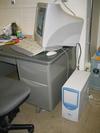
Thursday:
Well, we're not in Fort Sumner, yet. I'm waiting around the physics
building for my flight. I have this bad habit, when faced with an early
morning flight, to stay up all night instead of just going to sleep. Oh,
well, at least it gave me time to write the perl script that generates this
log. Above you can see the computer that is serving this web page. Just to
let you know, clicking on the thumbnails above an entry will take you to
that entry's gallery of pictures. In this entry's gallery are just some
pictures around the lab and my office here in Toronto. It's 4:30 here now, so
time to go home and pack.
Fri 2003-08-01 23:59:59 UTC
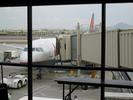
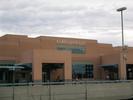
Friday:
I flew out of Terminal Three at Pearson. It took me a while to find America
West's ticket counter because they had cleverly disguised themselves as
Continental... almost. Because I was traveling light, I didn't check any
luggage. This meant that:
- I had to carry my luggage around with me at all times, and
- My luggage didn't end up in Murmansk (though presumably it wouldn't have
anyways).
On the flight from Toronto, I tried sleeping a bit, which worked all right until
we entered free fall (for a second or less), after which I didn't sleep much.
The airport in Phoenix was remarkably busy, much more so than Terminal Three
was in Toronto. The part I was in seems to be entirely run by America West,
which would seem to indicate they're doing fairly well. The layover was long
enough that I could find some lunch, a task made more difficult by the fact
that most places were only serving breakfast. The flight to Albuquerque was
so uneventful that I was able to doze off for a bit.
Once in Albuquerque the next challenge was to get to Fort Sumner. The car
rental place was a five minute drive by shuttle bus from the airport. I headed
over there but was unable to rent a car due to the fact that I had forgotten to
transfer money from my bank account to cancel my credit card debits. Not yet
admitting defeat, I decided to phone my bank to see if I could get my credit
limit increased.
This plan involved knowing my bank's telephone number, something which I
discovered they were rather coy about. I knew I would be able to find it
online, so I headed back to the airport to look for one. The Albuquerque
airport has a dearth of Internet access. The tourist information boother
verified this for me and said he didn't know the location of anything resembling
a Internet Cafe. He mentioned that the university was nearby and that there
might be something of that sort around there. Aha!, thought I, Universities
mean libraries, and libraries mean public access terminals. So I hopped on the
city bus (cost: $1.00) and headed down the road to the University of New Mexico.
Once on campus, it was necessary to locate a library. I asked a passing
student for directions. He told me to go down a certain path, past the Center
of the Universe, past the Duck Pond and then turn right. Center of the
Universe, thought I, riiiiiiiiight. Nevertheless I headed off in the direction
indicated. Much to my amazement, around the next corner I found the Center of
the Universe. There's a picture of it in the photo gallery. This, it seems
will have radical implications in the field of Cosmology. I found the library,
found a computer, and found my bank's telephone number. I headed back to the
airport. (Just as a side note, the airport is actually called the Albuquerque
International Sunport. I find this a rather absurd name, and will continue to
refrain from referring to it as such.)
Calling my bank, they weren't willing to extend my credit limit
sufficiently to allow me to rent the car, so I fell back on plan B, which was
to call the high-bay in Fort Sumner. I called and, as luck would have it,
Gaelen was just about to drive into Albuquerque to pick up Mark Halpern, who
was arriving just after 8:00 PM. It was now just after 5:00 PM, so I had to
kill a few more hours before he arrived. I considered going in to town for
a change of scenery, but the city bus stopped running at 5:30, so my plans
were thwarted. I remained at the airport.
Gaelen arrived around 8:00 and we waited for Mark ... who didn't show up.
After a few hours of waiting around and trying to locate him, we discovered that
his flight from Vancouver had been delayed, causing him to miss his connection
in Phoenix. He was however on a later flight that would arrive at 10:45. More
waiting ensued. He arrived on time, and we met up and then headed out. In
total I spent about nine hours at the airport and vicinity. Fun.
The next order of business was dinner, as we hadn't eaten yet. We drove
around Albuquerque looking for a reasonable place to eat, but ended up finding
nothing. After about an hour of this, we decided to give up and head out to
Santa Rosa, where Gaelen had seen a Denny's the previous day. The drive was
uneventful. In Santa Rosa we found the Denny's and also found that it was
closed .. very odd. The only other place we found was a truck stop which
served food of dubious but ingestible quality. It was now shortly after
2:00 AM. We ate and got back on the road. We finally got into Fort Sumner
after 3:00 AM, checked in at the hotel and fell asleep.
Sat 2003-08-02 23:59:59 UTC
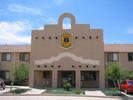

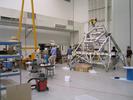

Saturday:
After being more-or-less up for 43 hours, it wasn't surprising that I slept
until noon. Stepping outside, I was immediately struck by how warm and dry it
was. Preferable to the humidity of the east coast. Having no other means of
transportation, I crossed the highway and headed up the road to the airport
(where the high-bay is located) on foot. Not far up the road from the highway
is a double track rail line. The frequency of trains appears to be
approximately 1.6 millihertz (one train every ten minutes or so). I managed to
get across the tracks just before a train came. I had planned ahead and bought
a bottle of water before leaving the hotel. This turned out to be a wise
decision. The trek to the airport took about 30 minutes, or one bottle of
water, in duration. Just as I turned onto the airport drive, I was met by the
BLAST fleet heading out from the high-bay for lunch. Perfect timing.
Lunch was at Sadie's, one of Fort Sumner's more upscale eating
establishments. Upon return to the High Bay, I found myself working mostly on
getting our lab computers up and running. Various hardware and software
annoyances arose. Galadriel, our data acquisition groundstation computer, had
somehow destroyed her memory during transport. Another of our computers,
Legolas, had managed to destroy his CPU fan. We have had a fair bit of consumer
electronics fail so far during BLAST work. Somewhat puzzling. For supper we
headed back to Sadie's, more from a lack of anywhere else to go than from a
desire to resample the cuisine.
Sun 2003-08-03 23:59:59 UTC
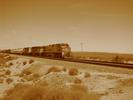
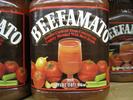
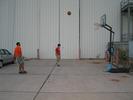
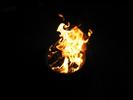
Sunday:
On the way to the high bay today I got stopped by a train, and entertained myself
by taking a few pictures. Just before the train tracks is a farm full of random
animals including two dogs who are always get excited and start barking when I
walk by. I wonder if they'll become used to me over time. Most of my day was
spent fixing more computer problems. It being Sunday, not much was open for
lunch, so we went to Dave's (the grocer) to buy some lunch fixings. We also
bought burgers and vegetables to for tonight's barbecue. Barth and company
arrived in the afternoon, made a brief appearance at the high-bay then headed
out to find their new house. In the afternoon, we had a brief rain, after which
some of us went out and played a little basketball. In the evening we went over
to the Penn House to have a barbecue.
Mon 2003-08-04 23:59:59 UTC
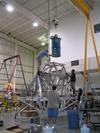


Monday:
Barth and I spent most of the day trying to get a replacement for Sam, one
of our redundant Master Control Computers (MCCs), up and running. Continuing
with the tradition, we were fraught with a myriad of inexplicable failures in
consumer electronics. We eventually managed to get a 800MHz Single Board
Computer to boot and installed it in the Pressure Vessel (PV). This is
significantly faster than the 233MHz original, but a test flight seems like
a good time to check to make sure the hardware will work. One worry is that
a fast CPU will me more susceptible to cosmic rays at reboot. The receiver
team mounted the cryostat and the primary mirror and began the arduous task
of attempting to align the optics.
Tue 2003-08-05 23:59:59 UTC

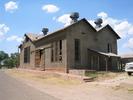

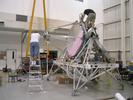
Tuesday:
David Hughes and Ed Chapin showed up today from INAOE in Mexico. More work on
the Pressure Vessel, mostly by Barth. I set up the SGR, a computer which is
going to be used to program our DSPs. It's a replacement for Gollum, which died
shortly before leaving Philadelphia. Legolas's replacement fan arrived and Matt
installed it. So far I haven't turned it on yet, though. I was hoping the PV
would be out of the way shortly but doesn't look like it. I went over to the
Brown House with Enzo and Matt for lunch. General consensus is that the Fort
Sumner Dining Scene isn't good enough that we need to frequent it frequently.
Starting in the late afternoon we had an amazing wind and thunderstorm, which
distracted most of us off and on. Lots of wind followed by lots of lightning
and a bit of rain. The receiver team finished aligning the primary. Over to
the UBC house for dinner.
Thu 2003-08-07 04:09:35 UTC
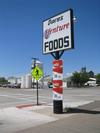
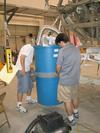

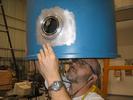
Wednesday:
Checked out of the Super 8 today in preparation for moving into the Japanese
House. The cryostat came off the gondola today in preparation for pumping down.
Barth spent most of the day battling with Sam's BLASTbus. Recreated the DSP
project files and memory map which were lost when Gollum died. Hooked up the
EPROM burner and burnt a chip. Now all we have to do is test them...
Resuscitated Legolas and put new memory into Galadriel.
Fri 2003-08-08 04:06:11 UTC
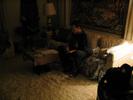
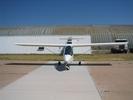
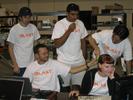
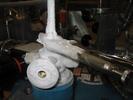
Thursday:
Moved into the Japanese house with Ed, David and Enzo last night. When we got
to the high bay in the morning, there was a cool looking plane refuelling at
the airport. The BLAST t-shirts arrived today, and everyone modelled them. The
receiver team pumped down the cryostat and filled it with liquid nitrogen to
start the cool-down. Barth started talking to the GPS. Mounted the sun sensor
and the roll flywheel motor on the gondola. Revamped the Toronto web-page; powered up the sun
sensor. The Star Camera guys took the camera out in the evening and took some
pictures of Polaris. In the evening Matt and the Penn people came over to the
Japanese House for dinner. Dave had baked bread and made pasta sauce.
Sat 2003-08-09 03:42:22 UTC
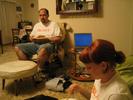
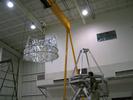
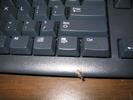
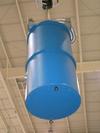
Friday:
So the blurring of time has begun. This morning I was looking at the
UPS tracking page and wondering why it was going to take four days to ship
something by 2nd Day Air... I had forgotten about the weekend. Someone else
estimated the day to be Tuesday or Wednesday. Some guys from the nearby
air force base stopped by to inform us that they were going to be doing some low
altitude F-16 flights. They have already been shaking the building with sonic
booms as it is. They left us a pamphlet of tips on how to avoid a mid-air
collision with a fighter jet. We figure when the time comes, we should
reciprocate and give them something outlining how to avoid mid-air collisions
with a large, slow-moving balloon. Had lunch again at Sadie's after a few days
of hiatus. Both the scoop and the Integrating Star Camera were mounted on the
inner frame today. The cryostat continued cooling, and preparation was made
for putting it back on the gondola. I booted the Star Camera computer and
verified it was working and then began the ordeal of installing Microsoft
Visual Studio on the SGR so I can tweak the Sun Sensor code a bit as necessary.
Went over to the Penn House for dinner, which Gaelen, Marie and Matt cooked.
After dinner, mounted the cryostat, DAS and receiver.
Sun 2003-08-10 04:44:21 UTC
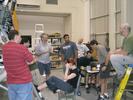
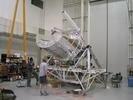
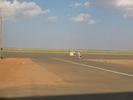
Saturday:
Barth spent most of the day trying to calibrate the GPS. I ran into trouble
with the SGR, which was frustrating. The gondola was hung in the afternoon,
in preparation for pointing tests. The passive roll damper and the fluid
balance system were installed. Also installed the flywheel encoder.
Mon 2003-08-11 17:27:18 UTC
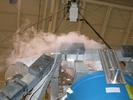
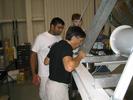
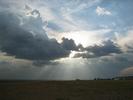
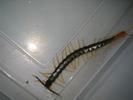
Sunday:
One of the thermometers in the cryostat is giving strange readings, so the
receiver team decided to warm up the cryostat. The pivot was lowered and the
pivot clinometer cable added before re-hanging the gondola. Mark's wife and
kids showed up yesterday (Sunday). Mounted both the ACS and the PV on the
gondola. After a bit of work, got the PV up and taking data from the ACS and
the DAS. Marie tried to power the Star Camera but ran into wiring problems.
Mark and Jeff took the GPS out and tried to calibrate it again.
Tue 2003-08-12 05:12:11 UTC
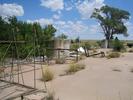
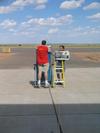
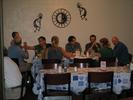
Monday:
Marie, Mark Halpern and Greg did more work with the ACS and ISC wiring and
eventually prevailed and were able to communicate with the ISC while it's
mounted on the gondola. Mark Devlin took the GPS out again to try another
calibration. The cryostat was taken off the inner frame and warmed up in
various ways. I tried the new Sam computer today, but need to wait for the CPU
to arrive tomorrow to make more headway. Mounted the PV again and cabled it
to the ACS and started reading sensors over the data bus. Verified the gyros
and elevation encoder are working. Moved the SIP Simulator so we can attach
it to the gondola and try commanding. Fred's reopened today, so we celebrated
the increase in culinary options by having dinner there. In the evening, we
tried to check the alignment of the optical axis with the axis of the Star
Camera by getting the ISC to look at a spot from a laser mounted on the
secondary mirror. Although it took some doing, we were eventually able to do
it. The optics box was opened, but no obvious reason for the thermometry
problem could be found.
Wed 2003-08-13 18:10:29 UTC
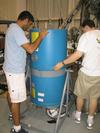
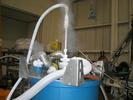
Tuesday:
The cryostat was closed up and pumped down. A new Sam CPU arrived so Barth and
I tried to get it to boot, but again ran into problems, much to our surprise.
The cryostat was cooled and finally remounted.
Big thanks to Carrie for restarting gimli after the blackout in Toronto.
Now all I have to do is get caught up...
Wed 2003-08-13 23:59:59
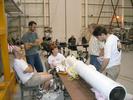
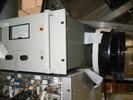
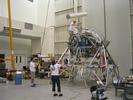
Wednesday:
The star camera came down today and was rewired a bit. I worked mostly on
trying to make the Sun Sensor/MCP code more robust, however the day was largely
frustrating. Went to Fred's for lunch. The BAPS was taken down and diagnosed
with a broken cooling fan. A novel solution involving white duct tape was
effected. Marie's mother arrived in town today. The star camera was remounted
and determined to be working at spec. This was Chris's last day here, as he is
flying to Las Vegas, NV tomorrow and then is driving back to Philadelphia with
a friend before getting ready to start Graduate School. In the evening, we had
an impromptu farewell party for him at the Japanese House.
Thu 2003-08-14 23:59:59
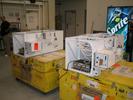
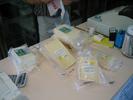
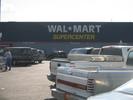

Thursday:
A slow day today in the high-bay. Marie went to Santa-Fe with her mother; Mark
Devlin went to Carlsbad with his family; Gaelen and Jaspaul took Chris to
Albuquerque for his flight and then did some shopping there. Ed, David and I
went to Clovis to shop for groceries. We bought about $100 of cheese and $300
of other groceries. A successful journey. After returning to Fort Sumner,
cooking and eating some of the groceries, we headed into the high bay and
proceeded to do a camera test, trying to capture some stars. A very good
learning experience.
Sat 2003-08-16 12:28:06 UTC

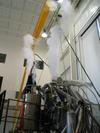
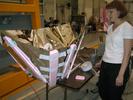
Friday:
The cryostat was filled with helium yesterday (Friday). I spent some time
working on narsil bugs I found while doing the camera test the night before.
Marie and I built a baffle for the artificial sun out of mylar, foam and duct
tape -- a winning combination. Put in a calibration for the sun sensor CCD,
but it turned out not to be quite right. In the evening, worked with Ed on
integrating the star camera commanding into linux.
Sun 2003-08-17 23:31:10 UTC
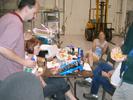
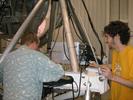
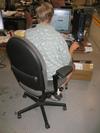
Saturday:
I worked with Ed for most of the day on Saturday, integrating the Integrating
Star Camera into MCP. The canister was removed from the gondola, and the SIP
simulator placed onto it. Also, Gaelen attached the roll flywheel, in
preparation for pointing tests. The cover for the primary was removed, in
anticipation of getting some telescope readings, which meant the inner frame had
to be rebalanced. In the night, Barth was given control of the gondola, and
managed to nail down a number of bugs in the pointing code.
Mon 2003-08-18 19:59:50 UTC
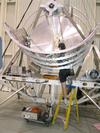
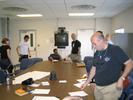
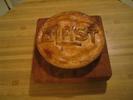
Sunday:
Bolometer testing continued Sunday. In the afternoon we had a planning meeting
to discuss what things needed to be done before flight. The ACS and the PVBOB
were both taken apart to make the modifications necessary to close them out.
In the evening Ed and David made an apple pie.
Interested parties might like to check out the NSBF video feed from the
high-bay.
Tue 2003-08-19 08:36:48 UTC
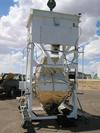
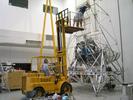
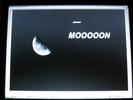
Monday:
The UBC guys assembled the sun shields today and we mounted them on the gondola,
in hopes of figuring out how they resonate with the pointing system. The front
and sides of the sun shields were assembled on the ground and then lifted by
hand onto gondola. Following this, Gaelen and Jaspaul were lifted up to the top
of the payload to attach first the top H of the sun shields and then the wings
(the portions of the sun shields that stick out forwards from the outer frame
on either side of the scoop). Finally the chin was attached to the ends of the
wings. In the evening we tried to do beam maps. The telescope can point down
to an elevation of approximately 15 degrees. So as soon as Mars rose above
this, we tried to scan it. We were unable to see Mars but managed to detect a
number of AWACS and F-16s dropping flares. Once a Mars observation was ruled
out, Barth took the gondola and did some pointing code tests until the moon
rose sufficiently for us to track it. We scanned the moon a couple of times
but again saw nothing. In the end it was decided that the air was too opaque
in the submillimetre to be able to see either target.
Wed 2003-08-20 19:00:24 UTC
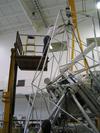
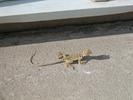
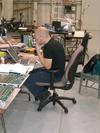
Tuesday:
Tuesday was filled with bug fixes in Flight Code Corner. Ed continued to work
on the ISC star identification and pointing solution code. Mark went up and
checked on the race motor and found it wasn't running. (So he fixed it.) In
the late afternoon, I skinned my knee playing Basketball. Marie and company
worked on the cooling system. Worked with Matt on the Motorised valves.
We went home early (around midnight) for a change to get a good night's sleep.
Thu 2003-08-21 22:22:09 UTC
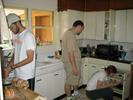
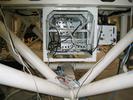
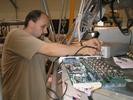
Wednesday:
I worked with Matt for part of the day on the motorised valves. We finally
managed to track the problem down to a bug in the DSP code. The NSBF guys
installed the SIP on the gondola today. David built some boxes out of blue
foam and white duct tape to insulate the cooling and balance pumps. Marie,
Matt Ed and Jaspaul filled the cooling systems with fluid. After that
the inner frame was re-balanced.
Thu 2003-08-21 23:59:59 UTC

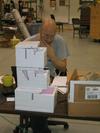
Thursday:
Got to the lab late due to staying up until six in the morning with David,
Matt and Jaspaul. I spent a bit of time working out the size of the signal in
the gyros due to the rotation of the Earth. Now that the commanding for the
motorised valves are working, Matt spent some time working on the mechanics
for them. In the evening we did a beam test of a source sitting on the top of
the forklift outside. We also tried using a balloon, but it was too windy to
get it stable.
Sun 2003-08-24 03:10:54 UTC
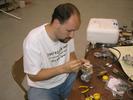
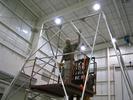
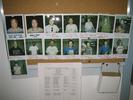
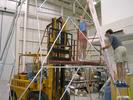
Friday:
Mark Devlin attached the GPS arrays to the sun shields and the long process of
mylarising the sun shields was begun. Barth continued to work on gyro drift
and integrated the magnetometer into the pointing solution. In the afternoon,
a number of us students took a trip to Dariland, the closest thing to a fast
food restaurant in Fort Sumner. It had been closed from the time we arrived
until recently. David cut PVC tubing to make cable braces for the flight
cables. Barth, Enzo and I fixed some electronic and DSP problems in the DAS.
Sun 2003-08-24 17:25:47 UTC
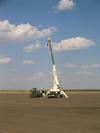

Saturday:
Phil Mauskopf arrived today. Matt installed the motorised valves and we
verified them to be working. Starting in the late afternoon, we began another
beam map. After our difficulties using the forklift, David had the idea to put
the source on top of the mobile crane, which would allow us to put it much
further away. A nitrogen dewar was fixed atop the crane some distance away from
the high-bay. Since we began in the daytime, we were able to locate the source
in the star camera window and were able to detect the source in the bolometers.
As it got darker, we put a couple of LEDs on the source to track with the star
camera. The final thing we did was to put a laser in the secordary's bore and
shone it on the target. Our most successful endeavour thus far.
Mon 2003-08-25 19:43:57 UTC
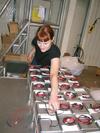
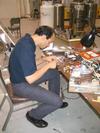
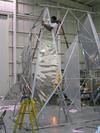
Sunday:
Being Sunday, Barth wasn't in, which gave me a chance to work on MCP a bit. Ed
and I successfully integrated the Integrating Star Camera into MCP and the
downlink and uplink. It was a relatively quiet and productive day. Phil worked
on gondola thermometry. We continued to cover the sun shields in foam and
mylar. Mark rebalanced the reaction wheel. Marie mounted the flight batteries
on the flywheel cover.
Tue 2003-08-26 22:19:02 UTC
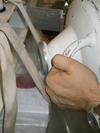
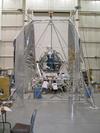
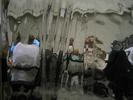
Monday:
Worked on issues related to ISC commanding with Ed. The mylarisation of
the sun shields continued. Enzo tested the Sun Sensor and discovered one of
the CCDs wasn't working. After some investigation, it proved to be dead. This
means we won't be able to measure the elevation of the sun relative to the
outer frame. However, since to a very good approximation the outer frame
is level, we already know the sun's elevation. What
we need from the sun sensor is azimuth, and we still have that, so very little
is lost. In the evening, Ed and I tried to take pictures with the star camera
integrated into the pointing solution. This was marginally successful, but
highlighted a number of communications issues that need to be ironed out.
Wed 2003-08-27 23:31:02 UTC
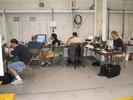
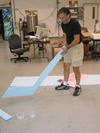
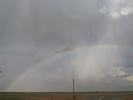
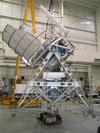
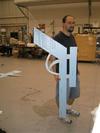
Tuesday:
Reimplemented the ISC communication protocols with Ed. The receiver team spent
most of the day doing noise tests. In the early afternoon, a threatening
electrical storm caused us to shut everything down for an hour or so. The storm
missed us and afterwards the gondola was raised and we did some simulated scans
to check noise in the detectors. Tried to debug the ISC link with the pointing
solution in the evening.
Fri 2003-08-29 19:20:24 UTC
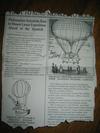
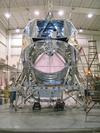
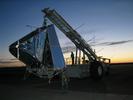
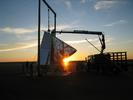
Wednesday and Thursday:
A long and eventful day (or two, depending on how you count things). We moved
out of the Japanese House with the arrival of the Japanese scientists for which
the house was named. I will be staying in the Billy the Kid Country Inn for
a few days until Barth and his family go back to Toronto. The cryostat was
removed from the gondola in preparation for the final warm-up. After the
cryostat came out Marie and Jaspaul had to rebalance the inner frame again.
Meanwhile the mylarisation of the sun shields was finished as well. David's
wife, Itziar, arrive from INAOE in the afternoon. Phil cooked dinner and
everyone eventually made it over to the Penn House there to eat, except Barth
who has his family to eat with.
After dinner, we went back to the high-bay where the sun-shields were
finished and then mounted. Barth and I spent the night finishing up the
pointing code in preparation for hanging the gondola on the Pi Frame in the
morning. After the gondola was together, we discovered that the truck plate
(which is what the gondola hangs from on the Mobile Launch Vehicle) was
backwards, which meant that the NSBF crew would have to turn it around before
lifting the payload with the Mobile Launch Vehicle (MLV).
Operations got underway around 5 AM. The truck plate was turned around and
the gondola was hung on the MLV. It was then carefully extracted from the
high bay with very little clearance on either side of the doorway. Following
this, it was carried over to the Pi Frame and then hung from that. The entire
operation took about an hour and a half. Once it was hanging on the Pi Frame,
the first thing that was done was to calibrate the GPS. After this was done,
we started doing pointing sensor tests.
The reason for putting the gondola on the Pi Frame is that most of our
pointing sensors don't work in the High-Bay. The GPS doesn't work in doors;
and the magnetometer's readings are off due to the large amount of metal moving
all around in the lab. We can use the fake sun to try and do tests with the
sun sensor, but this is difficult because it's beam is different than the sun.
The star camera can be used in a limited sense by pointing out the door in the
evenings. So, on the Pi Frame, we can turn the gondola around 360 degrees and
see how all the pointing sensors respond.
All our regular communications with the gondola are handled now through the
NSBF's electronics over the airwaves. Nevertheless, Enzo laid an Ethernet cable
from the high-bay out to the Pi Frame which allowed Barth to debug the flight
code from the high bay, instead of having to camp out at the Pi Frame.
By 8:00 AM, the wind had picked up sufficiently that we weren't able to use
the motors to servo the gondola, but instead relied on hand moving it and tying
it off to keep it stationary. Pointing tests lasted until noon, when the wind
picked up even more. However, the operation was generally successful. The
GPS works very well and the magnetometer worked well too. The sun sensor still
is dodgey and needs more work.
As soon as the pointing tests were done and the gondola shut down, Barth
drove me to the Billy the Kid Inn to sleep after the long day. During my nap,
Jaspaul and Mark Halpern left to fly back to Vancouver for the start of term.
I went back to the lab around 9 in the evening and Ed, Barth and I worked for a
few hours on the Integrating Star Camera pointing code. Eventually the command
link to the gondola died and we were forced to go home.
Sun 2003-08-31 19:07:33 UTC
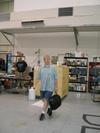
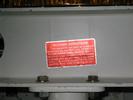

Friday:
Barth packed up his family and dog and headed back to Toronto today, after
giving me some last minute edicts. The sun shields and inner frame were removed
from the gondola in order to be able to drill the top hats onto the inner frame.
(Up until now, they have just been clamped on.) The NSBF guys got the
commanding issue fixed. In the afternoon there was a power failure which killed
our bit-sync, which gives us our high-rate data downlink. Some time was
required to re-establish the connection.
Sun 2003-08-31 19:56:04 UTC
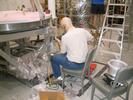
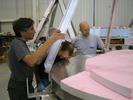
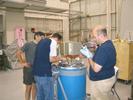
Saturday:
A loud day in the high bay as the holes for the top hats were drilled in the
inner frame. Additionally, Marie painted the scoop and, with Matt's help, the
struts white to reduce reflexion onto the mirrors. In the afternoon, we called
Rob Salter from the NSBF in to fix our network connexion which went down Friday
night.
Took the PV down today to try and install a new Sam. We had narrowed the
problem down to either being a bad PBP or a bad power supply. Initially the
new configuration didn't work in the PV despite it having worked on the bench
(albeit with a different DC-DC converter for power). After a bit of
investigation the problem turned out to be a couple of screws which held the
hard-disk flange were shorting out the backplane when it was installed in the
PV. This, naturally explains how we've always managed to get things to work on
the bench but never in the PV. Out comes the Dremel tool and away go the ends
of the offending screws. So, now we have a working Sam, which is good news, but
means a bit more complexity in the control systems now that has to be debugged.
Tue 2003-09-02 00:28:48 UTC
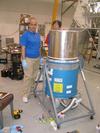

Sunday:
Adam, Marie's husband, arrived last night from Philadelphia. The inner frame
was re-assembled and put back on the gondola. The cryostat was also put back
together and we started pumping down in preparation for cooling it again. The
western part of the high-bay was cleared out to make room for the Japanese
collaboration which is going to be moving in over the next few days. I spent
part of the day trying to figure out why the low-rate and commanding weren't
working, and eventually concluded that the problem was with the SIP and not
our electronics. However, I couldn't get ahold of Gerald from NSBF to fix the
problem. Other than that, I worked on getting Sam up and running.
Tue 2003-09-02 23:41:51 UTC
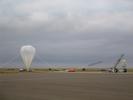
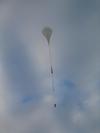
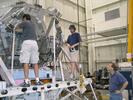
Monday:
Got up around 6:30 in the morning to watch the launch of the solar balloon
experiment, SBI. The
launch seemed to go quite well and the payload disappeared into the overcast sky without a sound. After the launch we went back home to sleep some more. Josh
Gunderson and Blazej Ruszczycki arrived from Miami yesterday and already are at
work. In addition to finishing the mylarisation of the scoop, they worked with
Gaelen on wiring thermometry around the inner frame. Enzo and I worked on
closing out the PV.
Thu 2003-09-04 22:30:11 UTC
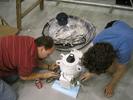
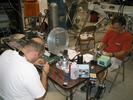
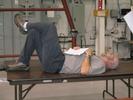

Tuesday:
Continued closing out the PV with Enzo. Enzo modified Sam's biphase card to
send down biphase, and then we secured everything on the Master Control
Computers. We are now gearing up towards flight and final preparations are
being made. The cryostat was reinserted into the cryostat for the final time.
Fri 2003-09-05 00:59:09 UTC
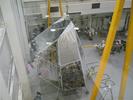
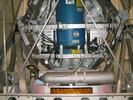
Wednesday:
The Pressure Vessel was closed up and pressurised today. Barth returned from
Toronto. The sun shields, minus a few panels, were put back on the gondola. In
the evening we tried to do more pointing tests with the star camera, but ran
into gyro problems.
Sat 2003-09-06 08:03:12 UTC
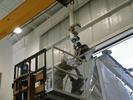
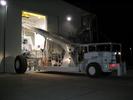

Thursday:
An initial weigh-in of the gondola was done today, and the result was 4335 lbs,
which is on the heavy side, meaning we're going to have to loose some weight.
It's not the exact weight of the gondola, since the weight included the
cryostat pump and some other stuff that we're not planning to fly. In the
evening we prepared to go outside on the Pi Frame again. At one, two hours
before we were scheduled to go out, we discovered a problem with the star
camera hardware, which meant Mark, Jeff and Marie were called back to the
high-bay to try and help debug it. The problem appears to be power related.
They managed to get it working again, at least temporarily, so we went out to
the Pi Frame on time.
The Pi Frame tests started with an attempt to tie the star camera pointing
solution to the one returned from the dGPS. This involved pointing the
telescope at different parts of the sky and seeing the difference between the
star camera and the GPS. The camera continued to see stars until about fifteen
minutes before sunrise. After sunrise, more sun sensor and magnetometer tests
were done. I also worked a bit with Gerald on the low rate data. Went home
around 11 Friday morning.
Sun 2003-09-07 00:23:29 UTC
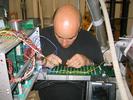

Friday:
Went back to work in the evening after supper. For light-weighting purposes,
the scoop has been removed from the gondola. Also an ice plug has been found
in the cryostat, so we're warming up the cold plate somewhat to try and remove
the clog. We have been getting bad reflexions in the BLASTbus due to impedance
mismatch between the cables and the ACS and DAS backplanes. Enzo and Barth
rewired the ACS backplane to try and reduce these reflexions with little
success. However, we managed to modify the phase shift between the clock and
the reflexions enough by doubling the length of the cable going to the DAS
that the reflexions are now masked by the rise and fall of the clock pulse.
This is a workable solution for the test flight, but a better one will have to
be made before the next one.
Mon 2003-09-08 01:05:24 UTC
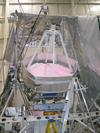

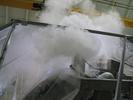
Saturday:
The scoop was removed from the inner frame and a new mini-baffle made of mylar
and foam was made. After refilling the helium, we noticed bad taconis
oscillations in the cryostat. In the end we decided to warm up the cryostat,
which means the flight will be delayed a few more days. Barth spent most of the
night working on gyro offset code. Josh and Blazej left today.
Thu 2003-09-11 00:10:05 UTC
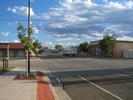
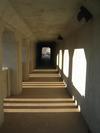
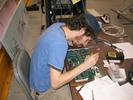
Sunday:
Woke up in the late afternoon and walked into the lab. When I got in, I was
informed of plans to go to Carlsbad Caverns on Monday. Hence, I didn't spend
much time at the lab because we planned to leave at 8:00 in the morning. Worked
with Gaelen on the outer frame thermometry a bit.
Thu 2003-09-11 00:59:49 UTC
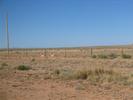
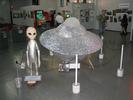
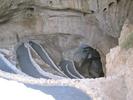
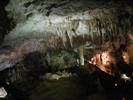
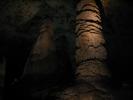
Monday:
Woke up at seven thirty after sleeping three and a half hours. Gaelen picked Ed
and I up at eight and after picking up Matt and Marie as well, we headed off on
our mandated day off to Carlsbad Caverns. Carlsbad Caverns is in the southeast
corner of the state, south of Fort Sumner. Our path lead us down NM Route 20,
for about 75 kilometres, during which time we saw four antelope and about the
same number of automobiles. Our path lead us through Roswell, we were decided
to make an impromptu stop at the International UFO Museum and Research Centre
(admission to the Museum is free, woo!) The reception personnel were very
concerned with learning where we were from and whether we came to Roswell
specifically to see the Museum... mighty suspicious.
After learning a lot, we had to recharge by going to Denny's and eating
Breakfast, Lunch, Brunch, or some sort of permutation of that. We then hopped
back in the car an headed down to the caves. The land was reasonably flat for
most of the journey until we got past the town of Carlsbad, after which things
finally started to get hilly.
Entrance to the cave is possible until 2:00 pm. We arrived about half an
hour before this. You have two options when visiting the caves: you can either
walk down via the natural entrance, or you can take the elevator down 700 feet
to the Big Room, which is the main part of the cave. We, naturally, elected
to walk down. The decent, though steep, was made significantly easier by the
paved walkway, electric lighting and hand rails throughout the trip. It was
by far the most built up cave I've visited. Throughout the cave are electric
lights shining on various formations in such a way to accent their shape or
interesting features. These lights are, for the most part, orange sodium light,
but greens, blues, red, etc. are also found. These coloured lights are designed
to emphasise the natural colours in the rocks, though it's a little unclear how,
say, bathing a rock in green light to show off the green tinting, is better than
lighting the same rock with white light and letting the tint come out by itself.
After the descent from the natural entrance, you come to a large cavern
housing the elevator lobby, a gift shop, restaurant and washrooms. A very odd
thing to find in a cave 700 feet below ground. Nevertheless we took a short
rest and then carried on to the main attraction: the Big Room (which is
essentially like the rest of the Caverns, but, um bigger.)r
One of the big attractions of the Caverns is the Bottomless Pit, which is
around the far end of the Big Room. From looking at the map we got at the top
of the cave, it looked like the thing to see. It was, however,
something of a disappointment. Not only is "Bottomless" Pit only 140 feet deep,
but the bottom of it is also brightly lit... Oh, well. On the whole the caves
were quite impressive and certainly worth the $6 entry fee. It would have been
nice to take one of the guided tours which take you through some of the less
developed parts of the cavern system, but time did not permit.
After finishing with the Caverns proper we were off to the Scenic Route in
the park. To our dismay, the scenic route appeared to be a gravel road to a
radio antenna with delusions of grandeur. Along the scenic route we managed to
see an oil pipeline, the aforementioned radio tower, and a couple of
automobiles. At least it gave Gaelen a chance to check out the handling of
his rental car. Finishing with the Scenic Route, we headed back to the Caverns
to throw pebbles at cacti and then, later, for the Bat Flight.
The Bat Flight happens daily at sunset except in winter when the bats
migrate to Mexico. A reputed 375,000 bats live in the Bat Cave in the Caverns,
with a mean density on the ceiling of 200 bats per square foot. As the sun goes
down, the bats wake up and start flying out of the cave. We watched for about
an hour as the quarter of a million bats exited the cave in a steady stream and
headed south over the Pecos River valley to eat bugs. You could hear distinctly
the sound of bat wings as they exited the cave.
Dinner was had at a Chili's in the town of Carlsbad where the overly
attentive staff assured we wanted for naught. The trip back was uneventful
until we turned back onto State Route 20 for the last leg of the trip. Suddenly
we were thrown into a hour-long fight between bunny and Buick as the brave
little lops hurled themselves in front of the automobile in a selfless attempt
to force the car off the road while Gaelen fought equally hard to persevere to
our destination. During this ordeal we saw nothing of other motorists, a
chilling, everpresent reminder of the rabbits' power.
For another view of the excursion and some really nice pictures of the cave,
you might like to check out Gaelen's
Photographs and Log.
Thu 2003-09-11 06:02:13 UTC
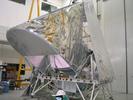
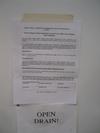
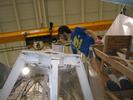
Tuesday:
Today was declared the final day for new features in mcp. After today, it's
only bug fixes. I spent most of the day working on the TDRSS downlink code,
which was developed last summer, and not used since. Barth worked on developing
scan modes and in the evening we did scanning tests. The cryostat is cooling
down again after having reached zero Celsius. Mark and Jeff biked out to the
windmills today.
Fri 2003-09-12 02:11:00 UTC
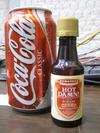
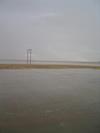
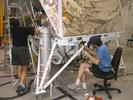
Wednesday:
A wet day today. A wiring problem was fixed in the Science Stack commanding
(on/off commands) for the receiver. The evening was spent doing scanning tests
with the Star Camera. It's working very well; we are able to spin around 360
degrees using just the inertial sensors and have the star camera re-acquire a
pointing solution at the end of the rotation without any problems.
Sat 2003-09-13 13:13:14 UTC
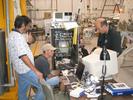
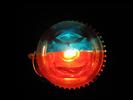
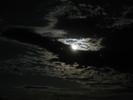
Thursday:
Enzo worked with the NSBF guys to get the 6-kbit TDRSS downlink working. I got
the calibrator lamp pulsing. We did pointing mode timing tests all night.
Sun 2003-09-14 11:40:17 UTC
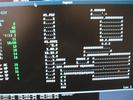
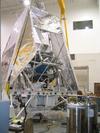
Friday:
We had a compatibility test in the morning. Basically, we have to turn on all
our stuff and the NSBF checks to see if we interfere with their commanding.
Naturally, BLAST passed compatibility. (It's not an RF source.) Matt and Gaelen
flew off with a number of NSBF guys to the downrange station in Arizona to set
it up. Take a look at Gaelen's Log for pictures and a summary of their trip. In the evening
we did a final checkout and code freeze of mcp followed by more scanning tests
in the early morning.
Wed 2003-09-17 22:38:49 UTC
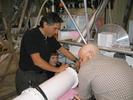

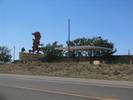
Saturday and Sunday:
Got up in the late evening and went in. Our plan was to do a test of the flight
schedule file on Sunday, so we spent the night preparing for that. We did a
flight battery test, which caused the star camera to crash, so Mark got Marie
out of bed and she came in to help diagnose the problem. After removing the
camera from the payload and putting it on a bench, we were unable to get it to
crash again when we switched from the Mega-A.P.S to the flight batteries. It
seems to be a temperature dependent power problem. Mark, Jeff and Marie
installed a ripple attenuation module to the output of the star camera's DCDC
converter to try and clean up the power going to the camera, and then the camera
was put back on the gondola. It seems to have fixed the problem.
After the excitement, we continued getting ready for our test, and began
the in-the-high-bay test test flight around nine in the morning. It was
Gaelen's birthday today. Marie and company baked Gaelen a cake.
In the morning we got the news from the weather guys: float winds are still
too strong (~33 knots) for us to be able to launch on Monday and get our 18 hour
minimum flight requirement. So, the pressure is sort of off. The next time
winds are low enough for us to launch is forecast for Friday. Barth and Ed
went home around eleven to sleep but I stayed around to keep an eye on the
gondola. Around two in the afternoon, Gaelen, Matt, Marie and I went to Clovis
to rent some DVDs to entertain us now that we have very little to do. We got
back to Fort Sumner in the evening, at which point I went directly to bed,
instead of watching the DVD for the night: The Hours.
Thu 2003-09-18 00:03:24 UTC

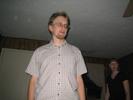
Monday:
Woke up around 7 in the morning and went in early. Barth, Ed and I are now on
schedules about 8 hours apart, making co-ordinating commuting and eating more
challenging. In the morning I fixed a bug I had found in the balance system
during our test flight. Other than that, didn't do much gondola software wise.
Wrote out a power up and power down sequence for the gondola. Went to Fred's
for dinner and some beer. Afterwards, went over to the UBC house to watch
tonight's movie: Spun. It was somewhat odd.
Thu 2003-09-18 19:16:05 UTC
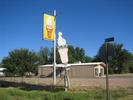
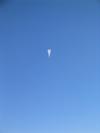
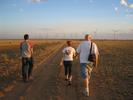
Tuesday:
Walked into work in the morning. As I was walking up the road to the airport, I
stumbled across the launch of one of the JPL experiments. This one is called
OMS in Situ I believe. Did a few scan tests. In the afternoon, Mark,
Jeff, David and Itziar headed off to Santa Fe.
Matt, Gaelen, Marie and I headed off to try and get to the windmills which
are everpresent on the horizon. We took the highway towards Clovis and turned
north at the village of Taiban towards the settlement of House, NM. After
ascending the ridge, we headed off on a gravel road, north, along the eastern
edge of the windmill reserve and passing the occasional No Trespassing. New
Mexico Wind Energy Center signs. Eventually we got to the north end of the
reserve and turned west. At the corner of QR 33 and QR BJ, where the road
turned north again, away from the windmills, we decided to park and trespass on
foot.
The windmills looked quite large and not too far away, perhaps half an hour.
After half an hour, the windmills were still about half an hour away. The power
poles that were in front of them, however, were now resolvable. After walking
further, we ran into (read "Ed almost stepped on") a rather annoyed rattlesnake.
We considered continuing, but it occurred to us that avoiding rattlesnakes would
be somewhat more challenging in the dark. We turned back. See Gaelen's page
for some great pictures of the day.
I had a nap on the way back to Fort Sumner. Back in town, we went to the
Penn House and had a barbecue and then watched the movie Ghost World.
Sat 2003-09-20 18:28:07 UTC
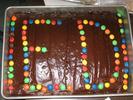
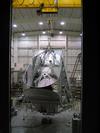
Wednesday:
We started final preparation for launch on Friday morning. It was Ed's birthday
and Marie had baked him a cake. I wrote a compressed downlink specification
file for Enzo who is debugging the 6 kilobit TDRSS downlink.
Sat 2003-09-20 18:54:43 UTC
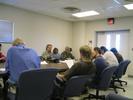
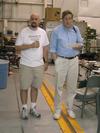

Thursday and Friday:
Early Thursday morning there were very high winds and it was difficult to
believe that they would die down enough to be able to launch the following day.
There was a weather briefing Thursday afternoon in which we learned that the
stratospheric winds were below 30 knots. In addition, surface winds were 2-4
knots, an acceptable range for launching our balloon. They told us another GPS
sonde would be launched around midnight to get an updated picture of the float
wind conditions. Both Mark Halpern and Greg Tucker had been notified before
hand and had flown in for the flight. Final preparations were made on the
gondola in the afternoon and early evening. Between eight and nine thirty in
the evening most people headed home to catch a few hours of sleep before our
scheduled pick-up at 2:30 Friday morning.
I went home with Ed to cook some dinner. Ed was planning to try and sleep,
but my plan was to stay up all night, watch the launch, then sleep during the
day so I could relieve Barth at the controls for the night shift. There wasn't
anything for me to do at the house and since everyone else was sleeping, I
didn't have anyone to drive me back to the lab, so I decide to walk. It was
shortly after ten at night; it was dark and quiet in town. Even the dogs which
usually bark when I walk past were asleep. I walked to the road that heads out
of town to the airport, crossed the railroad tracks and headed up the road.
The Pleiades were just rising. I revelled in the beauty of the clear, calm
night.
I had walked about half the distance to the cemetery from the railroad
tracks, when my world was illuminated my the headlights of a car approaching
from behind me. Things got brighter and brighter and I turned around to see
if the car was planning to run me down, or pass harmlessly by me. From the
search light mounted on the side of the car shining on me, I deduced that this
was either a state trooper or a local cop. I waited for the car to pull up
beside me. The officer inside asked me what I was doing and where I was going,
and after I explained, he offered to give me a ride to the base, so I arrived
quicker than anticipated.
Around one in the morning people started to trickle in to prepare for launch.
Around 1:30, Mark Devlin and Barth met with the NSBF guys to discuss the results
from the GPS sonde launched around midnight. Bad news: the float winds are
still too high (~30 knots at 127,000 feet), so Barth and Mark made the call to
delay the flight and wait for the stratospheric winds to die down to give us
a longer flight (we're hoping for at least 18 hours). Since the surface winds
were still good for a launch, the NSBF guys decided to launch the other JPL
payload. Barth and I went home to eat and (for me at least) to sleep around 6
am before the launch. Gaelen, however got some really nice
pictures of the launch.
I woke up in the evening and headed over to the Penn House for a barbecue and
to watch a bad movie (Suicide Kings). Using the JPL balloon as a
measure, though it's flying at a lower altitude, seems to me that the right
decision was made about delaying our flight. So for now we're still stuck here
in Fort Sumner. Our next possible launch day is Monday.
Sun 2003-09-21 18:15:55 UTC
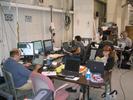
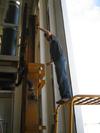
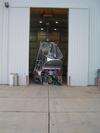

Saturday:
Woke up early and walked in. It was a very quiet day at the lab. Barth and
Enzo found a memory leak in the 6 kilobit downlink on Frodo and tracked it down
to an old version of a library. David and Itziar have been working really hard
on writing a new schedule file for Monday. Gaelen and Marie topped up the
nitrogen. We went to Tito Burrito for lunch and I had probably the best
restaurant meal I've had in this town.
In the afternoon the grad students decided to go to Clovis for bowling and a
movie. Bowling was fun. Matt won the first game handily and Ed was victorious
in the second, despite his clown shoe handicap. For dinner we went to the Pizza
District and ate some pizza. After supper we head to WalMart to do some
shopping. After the success of our last bargain DVD (Suicide Kings),
Gaelen decided we could hardly do worse by buying another $5.88 DVD. The
problem: with such a big selection, which one to pick? Gaelen came up with
a cunning plan: go across the street to the Hollywood Video and use their movie
guide to pick the best, cheapest movie. The rest of us bought some warm clothes
to survive the chilliness of New Mexico nights. After the shopping excursion, we
headed off to the cinema for the main feature: Matchstick Men.
Tue 2003-09-23 08:44:40 UTC

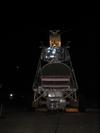
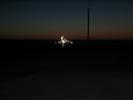
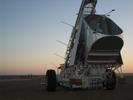
Sunday and Monday:
Launch Day! Again! Sunday was spent preparing for the launch Monday. The
weather briefing was favourable and we were go for launch. As usual, most of
us went home in the evening to try and catch some sleep before returning for
pick up at 2:30 am. I stayed in the lab. People started trickling in around
midnight. We got picked up shortly before three and headed outside.
Surface winds were almost non-existent. Initially, the launch crew from the
south, but some time before dawn we were redeployed from the north, with the
expectation that surface winds would shortly turn around. Then we waited.
I took a nap. The winds didn't turn around to the right direction. Around
eleven, the launch was scrubbed and we returned to the high bay. We'll try
again tomorrow. A frustrating experience; people are feeling depressed.
Fri 2003-09-26 07:48:30 UTC

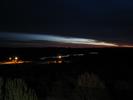
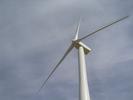
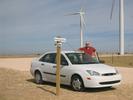
Tuesday:
Launch Day! Um, again! After the disappointment of Monday, we were picked up
again at the same time for another go. We rolled outside, put the ballast and
the crush pads on and then waited. And waited. Around four in the morning the
the NSBF guys came and told us the weather conditions were not good for launch.
We rolled BLAST back into the high-bay. Most people went home; a few of us
hung around the high-bay, mostly due to odd sleeping patterns. Around five,
Matt, Ed and I decided to drive to Santa Rosa to get something to eat, for lack
of something better to do. The Denny's (as mentioned above) was closed when we
got there forty-five minutes later, but appeared to be in the process of
opening up for the day. We guessed it probably opened at six, so we had to kill
a bit of time.
Having seen a sign for it outside town, we decided to head off
to check out Santa Rosa Lake State Park. The posted route led us on a
circuitous route through town, under the Interstate two or three times, past
the railyard where they seem to be unloading all of New Mexico's newly arrived
automobiles and then out into the hills. Santa Rosa Lake, like most lakes
around here is a dam reservoir. Also like most lakes around here, it's nearly
empty, due to the drought that these parts have been having. We got out of the
car and looked around only long enough to kill sufficient time to allow Denny's
to open.
We arrived back at Denny's about fifteen minutes after the hour and were
rather surprised to see a number of cars already in the parking lot, having seen
none during our initial casing of the eatery. A Denny's-esque breakfast was had
and we hopped back in the car. Being slightly tired, it seemed like a good idea
not to go directly back to Fort Sumner (where there was nothing to do), but
rather, head down the Interstate to Tucumcari (where there was likely nothing to
do either, but at least it was something different).
Tucumcari was filled with hotels and motels, but little else. There was
presumably a palaeontology museum somewhere in the vicinity, according to the
road signs. We bought some caffeine and a map. Instead of heading back the way
we came, we decided to take the secondary highways back to Fort Sumner, via
House, New Mexico. The road was straight, narrow and being upgraded. Just
outside the hamlet of Ragland, the road makes a sharp turn from south to east
while ascending sharply. The result is a very sudden transition from the mesa
dominated land typical of central and western New Mexico to the flat prairie of
eastern New Mexico. The road jogged back and forth generally south-eastward
from that point along the grid lines.
The state highway we were on met the Clovis-Fort Sumner highway at the town
of Taiban, but our plan was to head westward on a county road that was marked on
our map and come into Fort Sumner from the north. Heading along the highway
towards our point of departure, we suddenly, and much to our surprise, hurtled
past a billboard for the New Mexico Wind Energy Center. A brief deceleration,
a U-turn and a slight back-track had us at the yard containing the billboard
to investigate. During this manoeuvre, a truck had passed us coming the other
way. The truck had pulled into the yard just before us, so when we stopped at
the sign and got out, the driver came over to talk to us.
As it turns out, he worked for FPL Energy, the company contracted to build
the windmills. He told us that the they had just finished construction in July
and that they were just doing some minor finishing tasks, such as tightening
some of the bolts on some of the windmills. In addition some people from GE were
there to do work on the software that figures out which way the windmills should
point themselves, and the raking of the blades. He also took us on a brief tour
of the control center and showed us the Dell that monitors the windmills. He
then told us of a county road which we could drive down to get a bit closer to
the windmills.
After thanking him for the tour and the information, and perusing the
signage, we headed off to find the county road he told us about. The road was,
as advertised, not blocked off, although there was a sign at the gate saying No
Trespassing. It went for not more than a quarter mile before terminating at the
ridge edge .. sort of. There was a dubious looking track that headed down the
ridge and then off across the plain. Another access road followed the ridge
line and was blocked with chains. We got out of the car and looked at the
windmills for a bit. Then we looked at the view from the ridge for a bit.
We weren't really sure we wanted to take the track down the ridge, despite
Matt's zero liability policy on the rental car, so we headed back to the highway
and returned to Fort Sumner via Taiban.
Fri 2003-09-26 11:42:36 UTC
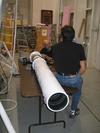
Tuesday (some more):
(This used to be labeled Wednesday, but I just figured out this is also from
Tuesday ... the part of it that happened after I slept and woke up again. The
whole figuring out what day it happens to be, whether the sun is up or down and
whether I should be sleeping or not is getting rather mucked up...)
Took down the star camera to install a relay to control the camera power
from the PC in hopes that we can recover from the camera errors more gracefully.
Sun 2003-09-28 02:20:32 UTC
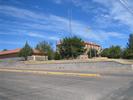
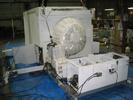
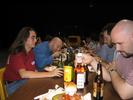
Wednesday:
No flight today. The camera power cycle relay was installed in the ISC and
tested and the ISC was remounted on the gondola. In the evening was a picnic
put on by the NSBF for the important NASA brass who came up from Wallops,
Virginia.
Sun 2003-09-28 02:58:21 UTC
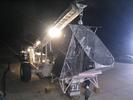

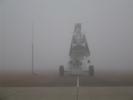
Thursday and the first half of Friday:
A launch attempt was scheduled for Thursday morning, but it was scrubbed without
us even being picked up. Gaelen made a mini-BLAST in the afternoon and staged
a mock
balloon launch for good luck.
Another launch attempt was made Friday morning. The weather looked promising
except for high low level winds. As we waited for the low levels to die down,
we got an unexpected surprise: fog! We waited for some time but eventually we
had to scrub the launch, not least because the gondola was soaking wet. Our
next launch attempt is Sunday.
Sun 2003-09-28 07:50:36 UTC
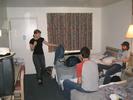
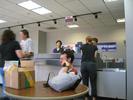
The second half of Friday and part of Saturday:
Slept a few hours in the afternoon and then Gaelen, Marie, Ed and I headed off
to Albuquerque to pick up a replacement CCD for the star camera as well as some
spare shutters that were to be waiting for Marie at the FedEx depot on Saturday
morning as well as run a few other errands. The drive there was uneventful.
We had dinner in an Indian restaurant that Gaelen knew about. Very tasty and a
welcome change. After that we headed off to the bookstore for a few hours
before retiring to a Motel 6 for the night.
In the morning, our first stop was the organic grocery store, where we also
had a bit of breakfast. The shopping done, we headed off to a recycling depot
to get rid of the bottles that Gaelen had accumulated in Fort Sumner (recycling
is a foreign concept in Fort Sumner.) Next stop was the FedEx depot where Marie
picked up the spare camera and some extra shutters. Our primary mission
completed, our last stop was the car rental place where Gaelen extended the
rental agreement on his car. We then headed back to Fort Sumner with our new
acquisitions.
Sun 2003-11-09 11:30:09 UTC
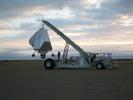
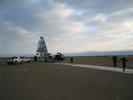
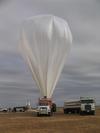
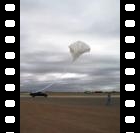
The rest of Saturday and the first part of Sunday:
Launch Day! (For real this time.)
But first we had some issues to resovle... We delivered the star camera stuff to Mark, who was
happy to get it. Of course, this meant the star camera had to come down, a little risky so close to
launch, but that's what ballooning is like. The camera shutter was replaced and we spent some time
testing the new camera. The new shutter seemed to open better than the old one. The star camera PV
with new camera was put back on the gondola. I went home to sleep for a few hours.
I woke up in the late afternoon or early evening. (Without regular meals, the dividing line between these two is rather indefinite). It being still light, I started to walk in. I walked about three
blocks from the house up to the Highway. As I was walking along a guy perhaps 20 pulled up and
offered me a ride. I accepted and we drove out to the airport. On the way I asked him what he did.
He said he was trying to get enough money to get out to California. He had nothing good to say about
the town, making such outlandish claims as "There is nothing to do," and "It's full of old people."
When I returned in the evening, star camera issues were still being resolved. A few pictures at
sunset allowed Ed to find the sensitivity of the new camera. The pixel noise of the camera was much
better than the old one and it didn't have the top-to-bottom gradient of the old one either, but the
overall sensitivity was too small to be of use to us. Result: we have to go back to the old camera...
which meant taking the camera down again to replace it. This is now about 10 pm... pickup is at 3:30
in the morning leaving less than four hours (we need at least an hour to do pre-pickup checkout of
the telescope) to do the tricky removal, disassemble the star camera pressure vessel, put the old
camera back into place, reassemble the star camera pressure vessel, leak check it, test the system to
make sure everyting is working and get it back up on top of the gondola. Most of the team had gone
home to try and sleep. They were recalled to assist Mark, Ed and Marie with the procedure. In the
end they managed it in time, and the old, dodgey camera was in place as we were picked up.
We headed out to the launch pad like we had done so many times before. The winds were projected
to be higher than they had been for some of our other launch attempts, but still low enough to
attempt launch. The MLV and spool truck were arranged into the flighline and we began to wait.
Shortly after sunrise, the orientation of the flightline was changed by a bit to align better with the
wind. The waiting continued. Eventually the riggers started laying out the tarps in preparation for
launch - a good sign. The graduate students, however, remained somewhat unoptimistic, perhaps due to
past experience.
We had our own stuff to do for final preparation. After the last launch attempt, we were,
naturally a little worried about fog. After removing the mirror cover, before going out to the pad,
we put a couple of pieces of plastic over the mirror -- just in case of more moisture. We now had
to remove this. The gondola, hanging from the MLV is quite high up, so we carefully pulled the bottom
of the plastic sheets. Unfortunately, one piece caught and didn't appear to want to come off. After
several attempts, inspections and a bit of worry, the plastic was removed. A small piece of plastic
was left hanging in front of the mirror, but it was basically transparent in the submm, so no one was
very worried. The second thing that was required, was to remove the pump line that had been attached
to the cryostat (and also close the trapdoor in the back of the sun shields.)
While we had been doing this, the riggers had started to unroll the balloon. This was the moment
of committment on the part of the NSBF riggers: once the box containing the $50,000 balloon is opened,
the balloon must be used or discarded. Because of the risk of puncturing the thin plastic, balloons
cannot be reused. Obviously the NSBF crew were confident of a launch.
The fill started shortly afterwards and lasted a while, upwards of an hour to fill the 40 million
cubic foot balloon with what looked like just a tiny amount of helium. As the balloon ascends the
balloon will inflate to full size as the atmospheric pressure drops and the helium inside the balloon
expands. Everyone with any sort of camera stood around waiting for the moment in order to document
it. The launch itself went without a hitch; the cleanest launch I saw at Fort Sumner. Because the
surface winds were lined up with the low level winds, when the balloon was released in rose right
over top of the MLV and the payload was carried off the pin to the back, just like it's supposed to
happen. The lesson: extremely low wind speed isn't the most important thing for balloon launch, but
knowing the wind direction and having it line up advantageously is the key. The NSBF riggers seemed
to think it was a pretty good launch too, or so it seemed from the cheering. After taking the movie
of the launch my camera decided it was done for the day: battery was dead. Fortunately I had bought
the fast Flash card which meant it was able to save the launch movie before giving up the ghost.
BLAST disappeared silently into the overcast sky and we all wondered if we'd ever see it again.
Fortunately we didn't have to wonder long since we could all just head inside and check out the
data being broadcast from the telescope. Launch was around 9 and it took about two hours to get to
float. On the way up, the gondola developed a slow rotation. After passing 90,000 feet Barth turned
the flywheel on, which stopped the rotation. The gondola was told to face away from the sun: we had
begun to point. We went through our pre-schedule file routine which involved balancing the inner
frame, unlocking it, and autofocusing the star camera. When we unlocked the inner frame, we
discovered that the limit switches had failed. This was actually unsurprising after the dry-ice test
that Marie had done earlier during integration. However, we had been wise enough to build in a manual
override for the limitswitches (because of Marie's test), so we activated that and were able to unlock
the motor.
The star camera too was acting up: crashing and rebooting willy-nilly ... just as it had done
during testing before launch, and what had prompted us to go and try and find a replacement. However,
it would stay up long enough to get a few pointing solutions, and the gondola seemed relatively happy
with this. One of the DAS boards was having issues, not reporting back data: a symptom of the
marginal BLASTbus, too. But persistance in restarting the DAS finally paid off as the board started
to work again reliably, giving us back the half bolometer array that it was responsible for.
I stayed around to watch the proceedings for a while. There wasn't much for me to do. However,
I was feeling very groggy and sleepy so I tried to doze a bit at my computer. (Matt and I had been
up the longest and gotten the least sleep on Saturday, the others having not come until the star
camera needed fixing or else just before pick-up.) Around 1:30 Barth had the brilliant idea (or so
it seemed to me at the time) tha I go home and get some sleep. Matt drove me home and I fell asleep
as soon as I lay down. (Aparently I wasn't worried about the success of the flight enough to keep
me up, a good thing, as I needed the sleep.)
Mon 2003-11-10 12:54:05 UTC
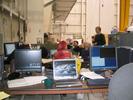
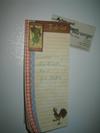
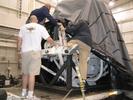
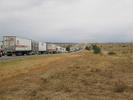
The rest of Sunday all the way to the following Saturday:
I woke up around eleven and phoned the high-bay to ask for a ride in. Word was
that BLAST was still up in the air. Barth drove in to town to get me, leaving
me to wonder who was driving BLAST. When I got in, I discovered that Mark,
Jeff, and Barth had stayed up for the entire flight. Ed had already made it
back in. Matt and Marie had left earlier that evening to go on recovery. In
addition to occasionally prodding the telescope, they were watching First
Blood.
The bad news was the star camera focus had frozen (out of focus, naturally),
which meant getting accurate pointing solutions would be tricky, which meant
making maps would be even trickier.
Termination occurred around 12:30 Monday afternoon, when BLAST was just
floating into the northwestern corner of the state. As we went through our
termination checklist, we discovered that the inner frame lock didn't work, most
likely due to it overextending itself when we unlocked it, due to the limit
switches failing -- a known problem. After vainly sending the lock command
several times, Mark had the good idea to pump all the fluid into the front
tank of the balance system, making the inner frame front heavy and ensuring
it would stay at it's lowest elevation (except perhaps at chute shock and
landing). We switched the balance system to manual, put the balance pump in
reverse and cranked up the speed.
After switching off the PV and transmitters and saying goodbye to BLAST, we
all turned our attention to NSBF's GPS feed which gave us an idea of how
fast our telescope was falling -- pretty fast, until the parachute opened.
The landing was very good: baffling everyone present BLAST managed to land
squarely on its crushpads, and the only real damage from landing was one
bent leg strut. The only other real damage sustained was at chute shock when
the pivot fell into the sun shields and sheared a cable or two and the inner
frame got jossled for not being locked. Matt and Marie saw BLAST coming down
and Matt managed to get some pictures of the
landing.
BLAST returned along with Matt and Marie to Ft. Sumner Tuesday evening, and
we all went out to welcome it back. In the meantime there hadn't been much
else to do besides putting the gondola cradle together and a bit of packing,
ugh. The telescope was in really good shape: the cryostat was even still cold.
As soon as he had the opportunity, Enzo took the Pressure Vessel off the
gondola, opened it up and started downloading data. In our first look at
the Frodo and Sam post flight, we noticed that both computers had turned back
on during descent: a result of the relays flipping when they got jerked on
chute shock. The cryostat was removed and vented.
Over the next few days, a combination of packing and leaving took place.
BLAST was broken up. The cryostat and receiver were headed back to Penn to
await installation of the new bolometer arrays. The primary and secondary were
going to Miami so Josh could characterise them in hopes to help our pointing
reconstruction. The rest of the telescope was packed up, but we had made no
plans to ship it, since the Toronto highbay wasn't ready to accept it. Barth Ed
and I were the last ones to leave: we headed out Friday afternoon to make our
flights Saturday morning from Albuquerque. On the Interstate we were stopped
for an hour or so due to a multiple car pileup caused by some roadwork. We
got into Albuquerque, stayed the night and were quite glad to fly back to our
respective places of living.
Last generated Fri 2025-07-18 22:40:12 UTC















































































































































































